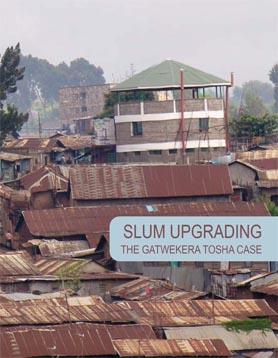Slum Upgrading in Kibera - The Gatwekera Tosha Case

Students: Ralf Figi, Karin Wegmann
Location: Group work in Nairobi
Date: December, 2007
Type: Research project, student work, A critical analysis of an exemplary upgrading project in Kibera
Upgrading is one of the ‘classic’ activities of NGOs in the context of slums and informal settlements. The aim of upgrading can be described as reducing a state of disadvantageousness, or, of making a miserable condition a bit less miserable. Examples of upgrading in informal settlements include repair or installation of infrastructure such providing better access to water or sanitary facilities. Other activities include the improvement of domestic and residential spaces, or providing community facilities such as spaces for gardening, cooking or recreation. In this sense, upgrading specifically and intentionally follows an ‘incremental’ approach, i.e. the aim is not to replace an informal settlement by something completely different, but to improve an existing condition.
The humanitarian NGOs are often one of the very few actors that are operating in these conditions of the disadvantaged. In many cases, the state and the local administration has withdrawn completely from slums (or has never been active) even though a large portion of a given population might live in these settlements. In the case of Nairobi, even though more than 60% of the population is said to be living in slums such as Kibera or Mathare, the city administration does not provide any services to these areas of the city. NGOs are therefore often seen as heroic institutions, providing citizens with basic rights. Within the realm of architecture, upgrading activities have edged out a central place within the profession, that is extremely high regarded, both by an academic and a lay audience, as it bestows architecture with a morale that is often thought to have gone missing in the recent years in this profession. On the other hand, the activities of humanitarian NGOs have also to be seen and studied critically: Aren’t NGOs by definition inefficient and uneconomical, as the scaling effects inherent in larger administrations can’t be achieved? Whose interest do the NGOs serve and who do they report to? Are the ‘pilot projects’ of upgrading really providing the services that they claim to be doing, or is the ‘marketing value’ for the NGOs higher than the ‘use value’ for the local population. Beyond these questions, we have to ask wether those humanitarian activities in the end maybe even add to the misery, as they can give governments an easy excuse to reduce their services even further, and as they insert themselves in between the relationship and the responsibilities of the government to its people. Being one of the very few actors trying to reduce misery, and at the same time exhibiting inefficiencies that are only aiding to despair, this architecture shows the dilemmas of humanitarian action.
Download the Book PDF

